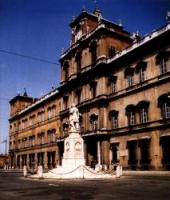|
 The history of Modena's development
includes a clear attempt to shift the focal point of the city
from Piazza Grande, the economic, political and meeting centre
of the late Middle Ages and the city state period. This shift
took place above all during the XVII and XVIII Centuries; in other
words, during the fist two centuries when Modena was capital of
the Este dukedom. In 1598, after the death without heirs of Alfonso
II d'Este, Ferrara returned to Papal rule and so the Este's dominions
were reduced to Modena, Reggio Emilia and Carpi. Cesare, the
new Duke, chose Modena as his capital. The city was provincial
and still strongly medieval in character, and so the Este family
set to work to give it a new, more monumental, more ducal look.
It is true that the Este dukes had already engaged in rebuilding
and expansion programmes in Modena in the XVI Century, but these
were mainly of a military nature in the northern part of the city,
where access to the surrounding countryside was by means of the
"Castello" gate, named after the nearby fortress built
in 1289 by Obizzo II d'Este. The city walls were lengthened to
include the area of today's corso Cavour and the railway station,
giving the city a new zone laid out on more modern, rational criteria,
with wide, straight streets meeting at right-angles (corso Vittorio
Emanuele II, via Ganaceto and via Santo'Orsola), very different
from the narrow, twisting streets that had followed the routes
of the city's canals in the medieval period. The change of focus
towards the north symbolised the Este's aim of making Modena a
true ducal capital, and their rejection of the medieval part of
the city more closely associated with the independent city state.
The history of Modena's development
includes a clear attempt to shift the focal point of the city
from Piazza Grande, the economic, political and meeting centre
of the late Middle Ages and the city state period. This shift
took place above all during the XVII and XVIII Centuries; in other
words, during the fist two centuries when Modena was capital of
the Este dukedom. In 1598, after the death without heirs of Alfonso
II d'Este, Ferrara returned to Papal rule and so the Este's dominions
were reduced to Modena, Reggio Emilia and Carpi. Cesare, the
new Duke, chose Modena as his capital. The city was provincial
and still strongly medieval in character, and so the Este family
set to work to give it a new, more monumental, more ducal look.
It is true that the Este dukes had already engaged in rebuilding
and expansion programmes in Modena in the XVI Century, but these
were mainly of a military nature in the northern part of the city,
where access to the surrounding countryside was by means of the
"Castello" gate, named after the nearby fortress built
in 1289 by Obizzo II d'Este. The city walls were lengthened to
include the area of today's corso Cavour and the railway station,
giving the city a new zone laid out on more modern, rational criteria,
with wide, straight streets meeting at right-angles (corso Vittorio
Emanuele II, via Ganaceto and via Santo'Orsola), very different
from the narrow, twisting streets that had followed the routes
of the city's canals in the medieval period. The change of focus
towards the north symbolised the Este's aim of making Modena a
true ducal capital, and their rejection of the medieval part of
the city more closely associated with the independent city state.
|